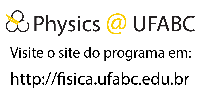Banca de DEFESA: HENRIQUE DIAS GOMES
Uma banca de DEFESA de MESTRADO foi cadastrada pelo programa.STUDENT : HENRIQUE DIAS GOMES
DATE: 07/02/2024
TIME: 14:00
LOCAL: Sala 302A do Bloco B do Campus de Santo André da Universidade Federal do ABC
TITLE:
Difusion of cosmic rays: a computational approach
PAGES: 109
BIG AREA: Ciências Exatas e da Terra
AREA: Física
SUBÁREA: Física das Partículas Elementares e Campos
SPECIALTY: Teorias Específicas e Modelos de Interação; Sistemática de Partículas; Raios Cósmicos
SUMMARY:
The study of ultra-high energy cosmic rays (UHECRs) is within the astroparticle physics, a branch of research that lies between elementary particle physics and astrophysics. This area has had enormous growth in the last decades due, in part, to advances in experimental techniques and the construction of new experiments with large areas of exposure, which allowed the exploration of energy regions where the flux is very low, leading to the discovery of new structures in the ultra-high energy particle and gamma-ray energy spectrum. Such advances lead to the solution of important problems in cosmic ray physics. However, several questions remain open, such as the unequivocal identification of astrophysical sources, composition, and processes of production and acceleration of UHECRs.
There are indications of anisotropy at ultra-high energies that point to the possibility of identifying the sources. However, a detailed study of the propagation of particles in galactic and extragalactic magnetic fields is necessary since it is known that charged particles must deflect themselves under the action of the Lorentz force on their way to Earth.
This work uses the EGCRProp software as a starting point. This program has an advanced and complete simulation structure of ultra-high energy cosmic rays, and our main goal is to include a variety of processes of interactions between highly energetic particles and cosmic background radiation. Such processes are responsible for establishing deviations in the trajectory of these particles and, in particular, one of them is the reason for the effect known as the Greisen-Zatsepin-Kuzmin limit (GZK cutoff).
This thesis is divided into three stages: The first is the theoretical development and complete bibliographic survey of the phenomena of pair production, photopion production, and nuclear photodisintegration. The second step is the computational elaboration of these models and their consequent implementation in our software. The third step is to effectively simulate different scenarios in the developed program, and then compare it with the CRPropa code, a reference simulation in the area.
COMMITTEE MEMBERS:
Presidente - Interno ao Programa - 1545176 - MARCELO AUGUSTO LEIGUI DE OLIVEIRA
Membro Titular - Examinador(a) Interno ao Programa - 1770888 - CELIO ADREGA DE MOURA JUNIOR
Membro Titular - Examinador(a) Externo à Instituição - RITA DE CÁSSIA DOS ANJOS - UFPR
Membro Suplente - Examinador(a) Interno ao Programa - 1780373 - LAURA PAULUCCI MARINHO
Membro Suplente - Examinador(a) Externo à Instituição - CARLOS JOSÉ TODERO PEIXOTO - USP




